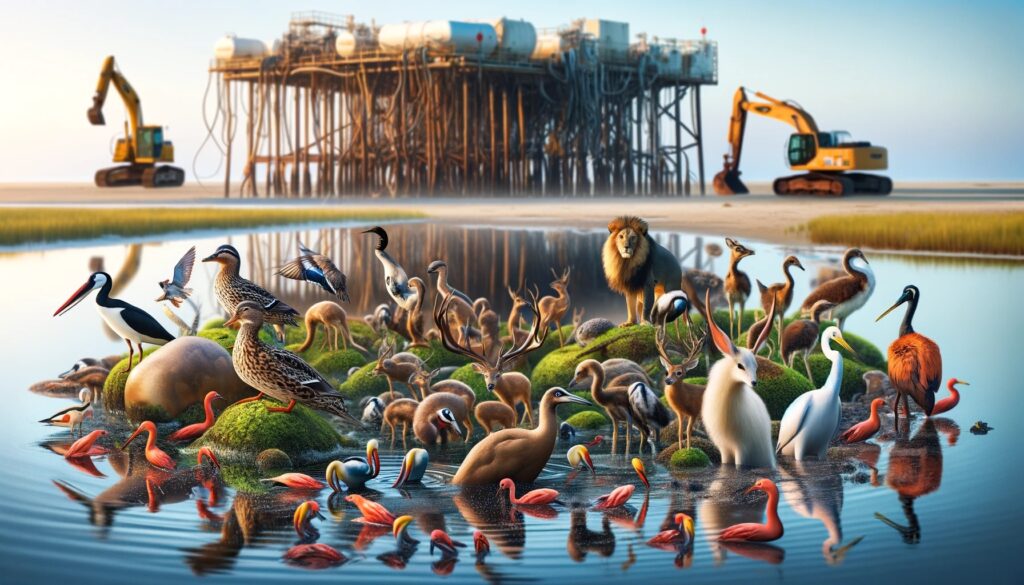The development of urban energy solutions plays a crucial role in meeting the increasing energy demands of our cities. However, as we strive for energy efficiency and sustainability, it’s essential to consider the impact of these projects on our natural environment, particularly wildlife. In this section, we delve into the intricate relationship between energy projects and wildlife conservation.

Habitat Disruption and Fragmentation
One of the primary concerns related to energy projects, such as the construction of power plants and energy infrastructure, is habitat disruption and fragmentation. These projects often require the clearing of land, which can lead to the destruction of critical habitats for wildlife species. When habitats are fragmented, it becomes challenging for animals to access food sources, breeding grounds, and shelter, leading to population declines.
Threats to Migratory Birds
Many urban energy solutions, including wind farms and solar installations, have been associated with threats to migratory birds. Wind turbines, in particular, can pose a danger to birds that collide with the spinning blades. Solar farms may also affect birds if they are installed in or near important migratory pathways. Mitigation measures, such as proper siting and bird-friendly designs, are essential to reduce these impacts.
Noise and Light Pollution
Energy projects often generate noise and light pollution, which can disturb wildlife in urban and suburban areas. Nocturnal animals, in particular, may be affected by excessive artificial lighting, which can disrupt their natural behaviors. Noise pollution from construction and operation can disturb animal communication, breeding, and feeding patterns. Implementing measures to minimize these disturbances is crucial for wildlife protection.
Land Use Conflicts
Urban energy solutions sometimes compete with wildlife for land use. For example, the development of bioenergy crops or urban agriculture may encroach on natural habitats. Balancing the need for renewable energy with wildlife conservation requires careful planning and consideration of land use policies that protect critical wildlife areas.
Pollution and Contamination
The energy production process can lead to pollution and contamination of air, water, and soil. These pollutants can have harmful effects on wildlife health. For example, pollutants from power plants can enter aquatic ecosystems and harm fish and amphibians. It’s essential to implement strict environmental regulations and adopt cleaner technologies to minimize these impacts.
Climate Change and Wildlife
Climate change, driven by the burning of fossil fuels, is a significant threat to wildlife. As urban energy solutions aim to reduce greenhouse gas emissions, they contribute to mitigating climate change’s effects on ecosystems. Wildlife is highly sensitive to shifts in temperature and habitat conditions, and addressing climate change is crucial for their survival.
While urban energy solutions are essential for meeting the energy needs of growing cities, they must be developed and implemented with careful consideration of their impact on wildlife. By minimizing habitat disruption, addressing pollution, and adopting wildlife-friendly practices, we can strike a balance between sustainable energy production and the conservation of our natural environment. It is imperative that energy projects prioritize both the well-being of our urban communities and the protection of the diverse wildlife that share our urban landscapes.
Strategies for Wildlife Conservation in Energy Sectors
In the pursuit of urban energy solutions, it is imperative that we prioritize the conservation of wildlife. As urban areas continue to expand, energy projects often overlap with natural habitats, posing risks to various species. In this section, we explore proactive strategies aimed at mitigating the impact of energy sectors on wildlife.
Habitat Restoration and Creation
One of the key strategies for wildlife conservation in energy sectors is habitat restoration and creation. When energy projects disrupt natural habitats, developers can offset the impact by restoring or creating new habitats nearby. This involves planting native vegetation, providing nesting sites for birds, and creating water features for amphibians and reptiles.
Wildlife Corridors
The creation of wildlife corridors is essential for allowing animals to move freely between fragmented habitats. These corridors are often vegetated strips of land that connect natural areas. They enable wildlife to access food, water, and breeding grounds without risking collisions with energy infrastructure. Properly designed corridors can significantly benefit species at risk.
Bird-Friendly Design
For energy projects like wind farms, adopting bird-friendly design features is crucial. This includes using technologies that deter birds from approaching turbines, such as radar systems that detect approaching flocks and temporarily shut down turbines. Additionally, painting turbine blades with patterns that birds can see helps reduce collision risks.
Monitoring and Research
Continuous monitoring and research are fundamental to understanding the impact of energy sectors on wildlife. This includes tracking the movement of animals near energy infrastructure, assessing population trends, and studying the effectiveness of conservation measures. Research findings can inform adaptive management strategies.
Public Awareness and Education
Raising public awareness about the importance of wildlife conservation in the context of urban energy solutions is vital. Engaging the community through educational programs, workshops, and outreach efforts can foster support for conservation initiatives. When the public is informed, they are more likely to advocate for responsible energy development.
Collaboration and Regulation
Collaboration among government agencies, environmental organizations, and energy companies is essential. Developing and enforcing regulations that require responsible wildlife conservation practices in energy projects can go a long way in protecting vulnerable species. Collaboration can also lead to innovative solutions that benefit both energy development and wildlife.
Renewable Energy Transition
Transitioning to renewable energy sources can have a positive impact on wildlife conservation. Renewable energy technologies, such as solar and wind power, generally have a smaller ecological footprint compared to fossil fuel-based energy sources. By supporting the shift towards cleaner energy, we can reduce habitat destruction and pollution.
Achieving a balance between urban energy solutions and wildlife conservation requires a multi-faceted approach. By implementing strategies like habitat restoration, creating wildlife corridors, and conducting research, we can minimize the negative impact of energy sectors on our natural environment. Public awareness, collaboration, and responsible regulation are also crucial components of this effort. Ultimately, our goal should be to ensure that energy development enhances rather than jeopardizes the well-being of our wildlife.
Case Studies in Energy and Wildlife Protection
Exploring Real-World Examples of Harmonizing Urban Energy Solutions and Wildlife Conservation
In our quest for sustainable urban energy solutions, it’s essential to look at real-world case studies where the integration of energy projects and wildlife protection has been successfully achieved. These case studies provide valuable insights into the strategies and practices that can help us strike a balance between urban development and the well-being of wildlife.
Solar Farms and Biodiversity Preservation
One notable case study takes us to the outskirts of Phoenix, Arizona, where a large-scale solar farm was developed. To protect the local wildlife, the developers implemented several innovative strategies. They established wildlife corridors within the solar farm, allowing animals to move freely between solar arrays. Additionally, the installation of bird-friendly features reduced avian collisions with solar panels. The project’s success demonstrated that renewable energy and biodiversity preservation can coexist.
Wind Energy and Bird Conservation
In the Altamont Pass Wind Resource Area of California, an extensive wind energy facility operates in an area known for its bird populations. To address the potential impact on birds, the facility underwent significant changes. Older turbines with higher bird collision rates were replaced with modern, bird-friendly designs. The installation of radar systems that detect approaching flocks enabled the temporary shutdown of turbines, further reducing bird fatalities. This case study illustrates the importance of adaptive management in the wind energy sector.
Green Roofs and Urban Biodiversity
Green roofs, which are becoming increasingly popular in urban areas, provide an excellent example of how urban energy solutions can enhance urban biodiversity. In cities like Chicago, green roofs have been implemented on a large scale. These vegetated rooftops not only reduce energy consumption by providing insulation but also create habitats for birds, insects, and plant species. Studies have shown that green roofs can support a surprising diversity of wildlife while contributing to energy efficiency.
Hydroelectric Power and Fish Migration
Hydroelectric power generation often involves dams and river diversions, which can impede fish migration. In the Pacific Northwest, the removal of obsolete dams on the Elwha River is a remarkable case study. The dam removal project aimed to restore fish habitats and allow salmon and other species to move freely upstream. While the primary goal was ecological restoration, it also had positive implications for energy efficiency. This example highlights the potential benefits of considering both energy and environmental factors in project planning.
Urban Solar Initiatives and Pollinator Habitats
In some urban areas, solar panels are being combined with pollinator-friendly plantings to create dual-purpose spaces. These initiatives not only generate clean energy but also support declining pollinator populations. One such project in Minneapolis transformed an underutilized urban area into a solar garden with flowering plants. This approach not only enhances urban energy solutions but also contributes to the conservation of essential pollinators like bees and butterflies.
Collaborative Efforts and Regulation
Across these case studies, a common thread is the importance of collaboration among various stakeholders. Government agencies, energy companies, environmental organizations, and local communities often work together to find solutions that benefit both energy production and wildlife protection. Robust regulations that require responsible practices also play a crucial role in ensuring successful outcomes.
These case studies demonstrate that it is indeed possible to balance urban energy solutions with wildlife protection. By learning from these real-world examples and adopting best practices, we can continue to make progress toward a more sustainable and harmonious future where urban development and the natural world coexist in synergy.
Future of Wildlife-Friendly Energy Practices
Envisioning Tomorrow’s Urban Energy Solutions with Wildlife in Mind
As we look ahead to the future of urban energy solutions, it’s imperative to consider the evolving landscape of wildlife-friendly practices within the energy sector. The harmonization of urban development, energy production, and wildlife conservation will continue to play a pivotal role in shaping our cities and the environment. In this section, we explore some visionary concepts and emerging trends that are expected to define the future of wildlife-friendly energy practices.
Technological Advancements in Renewable Energy
The future of wildlife-friendly energy practices is closely intertwined with technological advancements in renewable energy sources. Solar and wind power are expected to become even more efficient and eco-friendly. Innovative solar panel designs that minimize bird collisions and wind turbines with improved bird detection systems will likely become standard features in renewable energy projects. These advancements ensure that clean energy generation aligns with wildlife preservation.
Smart Grids and Wildlife Data Integration
Smart grids, enabled by advanced digital technologies, will revolutionize urban energy management. In the future, these grids will not only optimize energy distribution but also incorporate real-time wildlife data. For instance, sensors and AI algorithms could detect the presence of migratory birds or endangered species near energy facilities. This data-driven approach will enable proactive measures to protect wildlife while ensuring a consistent power supply.
Urban Green Spaces as Energy Resources
Cities of the future will increasingly leverage urban green spaces to generate energy sustainably. Rooftop gardens, vertical farms, and parklands integrated with solar panels and wind turbines will serve dual purposes. These green energy hubs will not only contribute to urban energy solutions but also provide habitats for wildlife. Birds, insects, and plant species will thrive in these urban oases.
Bioenergy and Habitat Restoration
Bioenergy, derived from organic materials, will play a significant role in the energy landscape. To ensure that bioenergy practices are wildlife-friendly, there will be a strong emphasis on habitat restoration and sustainable sourcing. Energy companies will invest in reforestation and wetland restoration projects to offset any environmental impact. Additionally, bioenergy facilities will incorporate features like bird-friendly biofuel crop management.
Collaborative Conservation Initiatives
The future will witness an increase in collaborative conservation initiatives between energy stakeholders and environmental organizations. Public-private partnerships will become the norm, leading to the creation of wildlife corridors, protected habitats, and green energy zones. These initiatives will be guided by comprehensive environmental impact assessments, ensuring that energy projects coexist harmoniously with wildlife.
Policy and Regulation for Wildlife Preservation
Robust policies and regulations will be enacted to safeguard wildlife in urban energy projects. Governments worldwide will impose strict guidelines on eco-friendly energy practices. Environmental impact assessments, wildlife monitoring, and adherence to international conservation agreements will be mandatory. Energy companies will be incentivized to adopt wildlife-friendly practices through tax breaks and other incentives.
Public Awareness and Education
Public awareness and education will play a pivotal role in shaping the future of wildlife-friendly energy practices. Citizens will be more informed about the importance of preserving biodiversity in urban areas. Educational programs and community engagement initiatives will empower individuals to advocate for wildlife protection in energy decisions, fostering a sense of responsibility among urban dwellers.
In conclusion, the future of wildlife-friendly energy practices promises a sustainable coexistence between urban energy solutions and the natural world. Technological innovations, smart grids, and collaborative efforts will ensure that energy generation not only meets urban demands but also respects the diverse ecosystems within our cities. As we move forward, a commitment to safeguarding wildlife and embracing eco-conscious practices will be at the heart of our urban energy evolution.





